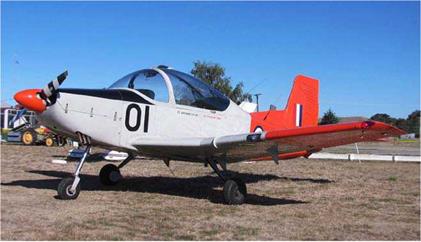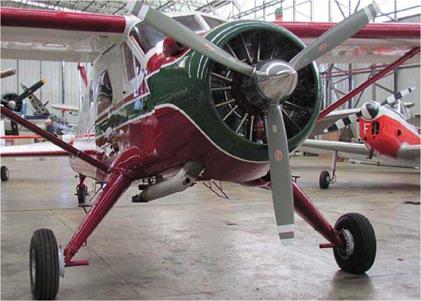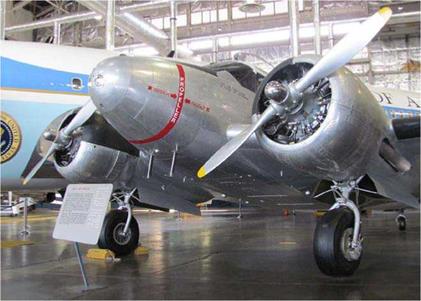Safety Around the Prop
The above paragraphs have covered propeller handling inside the cockpit; this section deals with handling the prop and moving around near the prop while on the outside of the aircraft. A rotating prop is an almost invisible blur and hard to see and hear when other aircraft are operating nearby. Safety around the prop is paramount at all times no matter if the prop is turning or stationary. The following are a few points to keep in mind when moving around the aircraft before and after flight. This maybe stating the obvious but accidents do happen that can be avoided.
The propeller per-flight involves the following:
• Check for leading edge knicks, cracks or dents
• Check the security of the prop spinner; it should be firmly secured in position
• Any signs of oil or fluid leaks require a more detailed inspection, which can be difficult if a prop spinner is in place. A leaking CSU can drain oil from the engine sump leading to an engine failure.
An accumulation of grass and dead bugs on the blades can lead to an unbalanced prop, plus a loss in prop efficiency due to the rough blade surface. A wipe over with an oily rag would solve this problem, along with an occasional polish with auto wax. Oil or dirt on the blades can be removed with carbon tetrachloride or a solvent; check the flight manual for the prop manufacturer’s recommendations for cleaning the prop blades
The propellers should never be used to man-handle the aircraft on the ground because this can place undue stress on the propeller and CSU. Holding onto a prop to pull or push the aircraft places bending stress on the prop blades. Maneuvering the aircraft by holding the prop at the blade root places stress on the CSU, the crankshaft and bearings. Whenever the aircraft has to be moved, always use the tow bar, recommended handgrips or taxi the aircraft under its own power. However, if you insist on using the prop, it is better to push or pull at the blade roots or the prop boss and not on the spinner, keeping in mind what was said above
Before the first flight of the day, it is usual practice to turn the prop by hand to clear the engine cylinders of ‘hydraulic lock’. ‘Hydraulicing’ as it is known, is caused by incompressible engine oil draining into the lower cylinders of a radial
|
This Victa CT4B Airtrainer has a very distinctive black and white stripe on the forward side of the prop for better visibility. |
engine preventing rotation during engine start-up. With the horizontally opposed type of engine, hydraulic lock is not a problem; therefore, it is not necessary to turn the engine over by hand. Nevertheless, if you do decide it must be turned over, then turn the prop in the direction of normal rotation and never backwards, as damage maybe caused to the engines ancillary equipment, such as the vacuum pump, etc. The term ‘pulling through’ or ‘hand turning’ are applied when the prop is turned by hand for reasons other than starting the engine.
A few simple rules apply to swinging the prop by hand to start the engine:
• Check the aircraft is parked into wind with the brakes ‘on’, preferably with the wheel chocks in place with the tail pointing away from the hanger and other buildings or aircraft
• The plane should be sitting on a smooth, firm surface, so you won’t slip over when you swing the prop
• Do not wear any loose clothing that may get in the moving prop
• Keep both feet firmly on the ground, one foot in front of the other so you can quickly step backwards after each swing of the prop, incase the engine starts.
Some pilots may dispute this last method having their own variation on the theme. However, what ever method is used, hand-propping is now a dying art and caution should prevail. If you have any doubts about swinging the prop, seek help from an experienced pilot or flight instructor. Besides, an experienced pilot should be at the controls any way. Hand propping solo, has on many occasions allowed the aircraft to taxi away and collide with other aircraft and buildings, etc, or become airborne with no one at the controls.
|
This DH Beaver has white prop tip stripes on its grey prop. The DH Chipmunk to its right also has a high-visibility prop. |
A constant-speed prop can be moved fore and aft by a small amount; this movement is allowable and is known as ‘blade shake’.
Always treat the prop with care and attention it needs and deserves . In addition, always check the mags are off and the throttle closed before touching the prop. It can be a lethal device if the engine starts unexpectedly, so not touch it unless absolutely necessary. Pilots and passengers alike have a fascination for propellers and having their photos taken while hanging onto a prop blade. Imagine the result if the engine turned over! Your passengers should be warned of the dangers of the propeller and be escorted by you to and from the plane. Do not allow people to board or de-plane with the engine running Stepping off the leading edge of a low-wing plane when the prop is turning is asking for trouble because the prop is difficult to see from that position. The prop is an almost invisible disc when viewed from the rear of the plane and there are not many rotating devices in an unguarded state in any other industry. A rotating prop is as dangerous as a butcher’s ham slicer. The prop can slice off an arm or a leg quite easily. Ensure the prop is stopped before anyone gets near it
Prior to engine start, it is essential to ensure the area around the aircraft is clear of all personnel and that no one is in danger of walking into the rotating propeller. This author always used the pre-start check “all clear, front and rear” to ensure no one is in danger of walking into the rotating prop . The old method of calling “Clear prop” before starting is still a good point of airmanship, but hardly ever used these days. Turning on the rotating beacon prior to start-up also helps to warn people of your intention to start.
Military aircraft usually have markings – prop warning lines – on the forward fuselage to warn of the location of the propeller. However, manufacturers of civilian aircraft are reluctant to post warnings on their aircraft; is it for aesthetic
|
A prop warning line on a Beech C-54 (Model 18) Expeditor. This aircraft is located in the National Museum of the USAF, Dayton, Ohio. |
reasons? They could help prevent someone from walking into the rotating propeller. On single-engine aircraft, the words “Prop” and arrows, pointing forward towards the prop, could be painted on the engine cowl. This could be a good safety feature on aero club/flying school and personal aircraft, where less experienced pilots are operating these aircraft and taking friends along for rides
Safety around the prop is the pilot-in-command’s responsibility at all times, either from inside the cockpit or outside the aircraft.
Conclusion
The workings of an aircraft propeller involve many variables Some factors work together to enhance the prop’s efficiency while other factors oppose efficiency. The result is a propeller suitable for one aircraft may not be suitable for another. Propeller design has seen many changes over the years; changes in blade planform and tip shape and also changes in materials used in their manufacture. All these changes enhance the efficiency of the aircraft propeller. How will the design of future props change? And what benefits will they have over present day props? Today’s props generate greater thrust more efficiently than the props mounted on aircraft of years gone by. Their performance has improved tremendously over the years. Therefore, we can expect to see some new and interesting innovations in prop design in the future as new aircraft types are brought onto the flight line.
However, it is not only new aircraft types that are benefitting from the new prop designs, because new props are now being deigned for individual aircraft types both old and new. It is no longer necessary for the aircraft designer to choose ‘off the shelf’ propellers as was once the case. The prop manufacturers are refining the prop’s design, so now props with three blades producing better cruise speed performance on aircraft which were once powered by two-blade props.
There is no doubt the prop is an ideal thrust generator for aircraft flying in the lower speed range, below 350 knots and will always remain so. Since the early 1960s, the jet engine has reigned supreme as the prime mover of large transport aircraft. With the advent of the Propfan design in the later half of the 1970s, will the propeller go full circle (pun intended) to make a comeback and once again power the medium to large aircraft of the future’s airlines? Maybe not. With more than half the world’s aircraft powered by propellers driven either by piston-engine or turbine power, the propeller powered aircraft is going to be with us for many years to come.














